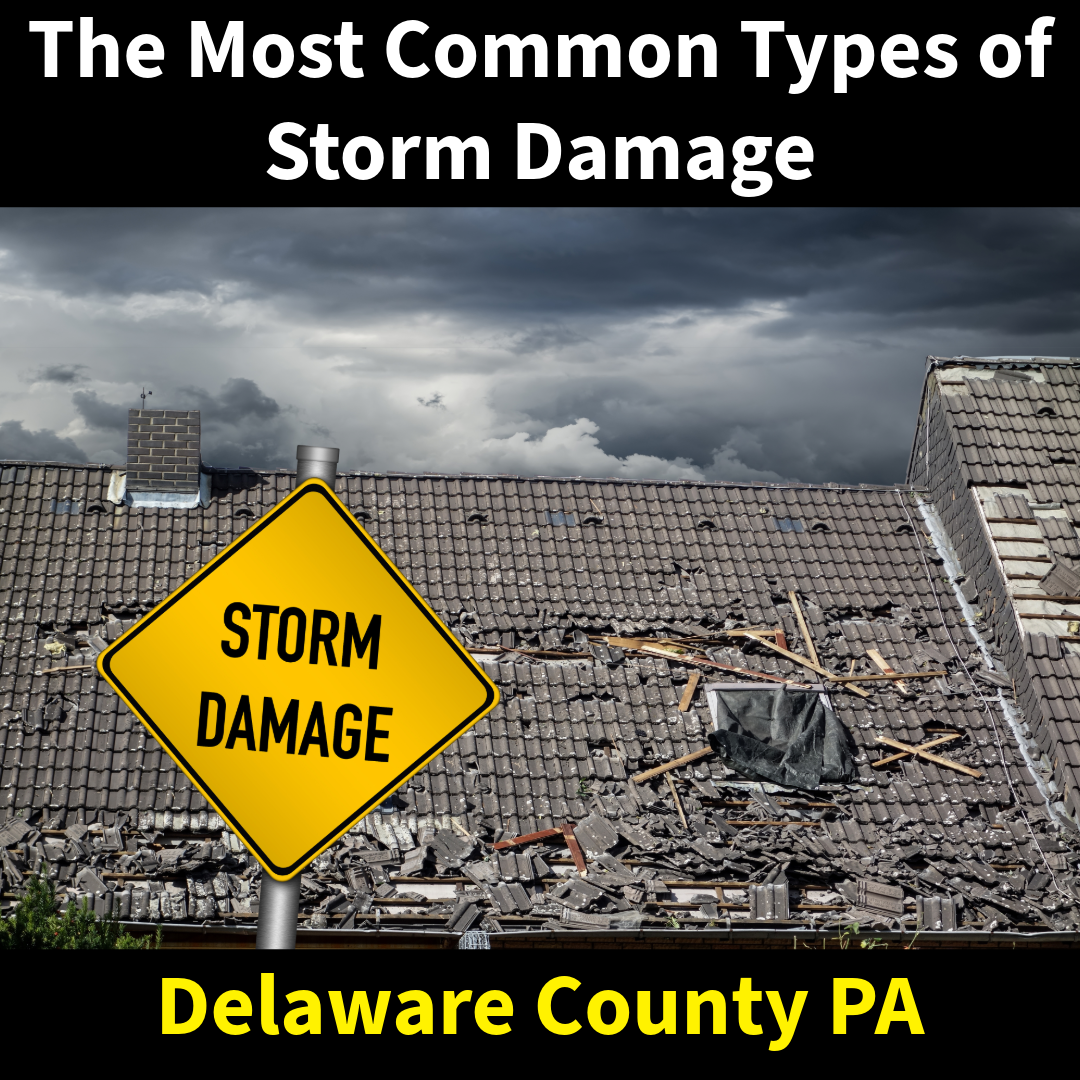Delaware County PA, like many areas on the East Coast, is no stranger to severe weather. From heavy rainstorms to winter snowstorms, these conditions can cause significant damage to homes and businesses. Understanding the most common types of storm damage can help you prepare and act quickly if disaster strikes. Here’s an overview of the storm damage types you might encounter in Delaware County and how to protect your property.
1. Wind Damage
Strong winds are often one of the most immediate threats during storms in Delaware County. Winds of 50-70 mph (common in strong thunderstorms) can cause substantial damage to homes, trees, and power lines.
Common Issues:
- Roof damage: Shingles, flashing, or even entire sections of a roof can be torn off.
- Fallen trees and branches: Trees and large branches can fall on homes, vehicles, or power lines.
- Broken windows: Flying debris or falling tree limbs can break windows, allowing rain to enter.
What to Do:
- Trim overhanging branches regularly to reduce the risk of damage.
- Consider installing impact-resistant windows and reinforcing your roof.
2. Flooding and Water Damage
Heavy rainfall or snowmelt often causes localized flooding, especially in areas near rivers, streams, or poor drainage zones. In Delaware County, storms can overwhelm local infrastructure, leading to water seeping into homes and businesses.
Common Issues:
- Basement flooding: Poorly sealed foundations or backed-up sump pumps can lead to water entering basements.
- Damaged foundations: Prolonged exposure to water can weaken the foundation, causing cracks or shifts.
- Mold growth: Floodwater can leave damp conditions in its wake, fostering mold growth.
What to Do:
- Ensure your sump pump is in good working condition.
- Seal any cracks in your foundation and waterproof your basement.
3. Hail Damage
Hailstorms are a frequent cause of damage during spring and summer months in Delaware County. Hailstones can range from small pellets to golf-ball-sized chunks, and they can cause serious harm to roofs, windows, and vehicles.
Common Issues:
- Roof damage: Hail can crack shingles, leaving your roof vulnerable to leaks.
- Car damage: Vehicles left outdoors can suffer dents, broken windows, or damaged paint.
- Broken windows: Hailstones can shatter glass, allowing rain to enter your home.
What to Do:
- If a hailstorm is expected, park vehicles in a garage or sheltered area.
- Install impact-resistant roofing to minimize hail damage.
4. Snow and Ice Damage
Winter storms can lead to dangerous conditions like heavy snow accumulation and ice. These conditions pose risks both during the storm and as they thaw, with water entering buildings and causing further problems.
Common Issues:
- Ice dams: Ice forming along the edge of the roof can block water from draining, leading to leaks inside the home.
- Collapsed roofs: Excess snow can accumulate on roofs, leading to a risk of collapse, especially if the snow is wet and heavy.
- Frozen pipes: Freezing temperatures can cause pipes to burst, leading to water damage inside the home.
What to Do:
- Regularly clear snow from your roof and gutters to prevent ice dams.
- Insulate pipes in colder areas of your home, such as basements or attics.
5. Tree Damage
Heavy winds and rain can make trees unstable, causing them to fall onto your home or other structures. Fallen trees are especially common after intense storms or hurricanes that loosen soil or uproot trees.
Common Issues:
- Tree falls on roof or car: A large tree can collapse onto a roof or vehicle, causing significant damage.
- Blocked entryways: Fallen branches or entire trees can block driveways and paths, impeding access to your property.
What to Do:
- Have trees inspected regularly, especially if they’re near your home or power lines.
- Trim weak branches that could fall in high winds.
6. Power Outages and Electrical Damage
Severe storms can knock out power for hours or days, which can cause damage to electrical systems and appliances. Power surges, downed power lines, and flooding can lead to dangerous situations.
Common Issues:
- Power surge damage: When power is restored after an outage, it can cause a surge that damages electrical appliances and systems.
- Downed power lines: Fallen power lines can create fire hazards and cause electrocution risks.
What to Do:
- Invest in a surge protector for valuable electronics.
- Never attempt to remove downed power lines yourself—always call the utility company.
7. Storm-Related Mold Growth
Excessive moisture from flooding or a damaged roof creates the perfect conditions for mold. Mold can start growing within 24-48 hours, causing health problems and long-term damage to your property.
Common Issues:
- Black mold: This toxic mold grows quickly in damp environments like flooded basements or attics.
- Health issues: Mold exposure can cause respiratory problems, allergies, and other health complications.
What to Do:
- Address any water damage or leaks immediately.
- Consult a mold remediation specialist if you suspect mold growth.
Conclusion
Storm damage in Delaware County can range from minor inconveniences to major disasters. However, by understanding the common types of storm damage and taking preventative measures, you can reduce the risks and protect your home.
If your property has suffered storm damage, Mold Solutions & Inspections is here to help with expert restoration services. From water extraction to mold remediation, we’re ready to restore your home to its original condition.
